Louis Pasteur

Louis Pasteur (born December 27, 1822 in Dole, Jura department; † September 28, 1895 in Villeneuve-l'Étang near Paris) was a French chemist, physicist, biochemist, and co-founder of medical microbiology who made decisive contributions to the prevention of infectious diseases through vaccination.
Pasteur began his career with a discovery in the field of chemistry: from two asymmetrical, mirror-image crystal forms of a salt of racemic acid and their optical activity when placed separately in solution, he deduced their underlying molecular asymmetry. Thus he became the founder of stereochemistry. Optical activity, in Pasteur's eyes, was a property that characterized the molecules of living things. Since fermentation produced optically active substances, he suspected that it was caused by microorganisms. He was able to prove this in a series of experiments, thus ruling out the competing hypothesis, which had been advocated by Justus Liebig, for example, that these were purely chemical reactions without the involvement of living organisms. At the same time, the question of whether life could arise spontaneously under everyday conditions, which had been debated since antiquity, was considered to have been decided. In the course of his studies on fermentation, Pasteur discovered that there were microorganisms that could manage without oxygen, and he found the first example of metabolic regulation when he observed that yeast cells consumed sugar more rapidly in the absence of oxygen. Pasteur described different forms of fermentation and realized that this required different types of microorganisms. A practical consequence of this work was a process for preserving liquid foods, pasteurisation.
On behalf of the French government, Pasteur researched various diseases of silkworms and recognized them as infectious diseases. From 1876 he devoted himself entirely to human and veterinary medicine. He developed a vaccine of attenuated pathogens to protect against fowl cholera and thus developed vaccination - for which there had previously only been the example of smallpox vaccination in human medicine - into a general principle in the first place. Further vaccines against anthrax, swine erysipelas and rabies showed that, at least in theory, it was henceforth possible to prevent any infectious disease. With his work on fermentation and vaccination, Pasteur demonstrated the economic and medical potential of experimental biology. The production of the anthrax vaccine marked the beginning of the vaccine industry. A wave of donations following the first spectacular rabies vaccination of the boy Joseph Meister allowed the foundation of the Institut Pasteur, to this day France's leading scientific institution in biomedical research.
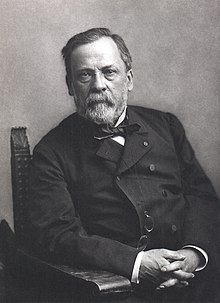
Louis Pasteur, studio recording by Paul Nadar
Live
Louis Pasteur came from a family of tanners (his father was the tanner Jean-Joseph Pasteur) and, after several moves, grew up in Arbois, where he attended grammar school. The third of five children, he initially stood out at school, if at all, for his artistic talent. In 1837/38, however, he won so many school prizes that he was advised to prepare for the École normale supérieure, the faculty of education, in Paris. The first attempt failed because he was too homesick. In 1842 he passed the Baccalauréat (grade in chemistry: "mediocre") and was admitted to the École Normale, but declined because he was dissatisfied with his rank (15th out of 22 candidates). He completed another preparatory year and this time achieved rank 4.
For the next five years Pasteur studied at the École Normale and at the same time worked as a scientific assistant (préparateur). In 1846 he passed the teaching examination for physical sciences in Paris. In 1847 he was awarded a doctorate in natural sciences (docteur-ès-sciences) on the basis of two doctoral theses in physics (investigation of the phenomena of the rotatory power for polarized light of liquids; application of the rotatory power of liquids to the solution of various problems in chemistry) and chemistry (investigations of the saturability of arsenious acid; investigation of the arsenious acid salts of potassium, sodium, and ammonium). After a brief stay at the end of 1848 as a high school professor of physics at the Lycée of Dijon, he went to the University of Strasbourg in January 1849 as assistant professor of chemistry (professeur suppléant). Here he fell in love with Marie Laurent, the daughter of the rector of the Strasbourg Academy. He married her on 29 May 1849 and his wife gave birth to five children, three of whom died in early youth. By 1853 his scientific reputation had grown to such an extent that the Pharmaceutical Society (Société de Pharmacie) awarded him a prize of 1500 francs and he was admitted to the Legion of Honour.
In 1854 he was appointed professor of chemistry as well as dean at the newly founded Faculty of Sciences in Lille. Here, Pasteur advocated strongly applied research in the interest of local industry; he also championed an innovation introduced by an imperial decree in the same year that students of the natural sciences should be trained in the laboratory.
In 1857, at the age of 34, Pasteur was appointed director of scientific studies as well as administrator (comparable to a chancellor at a German university) at the École Normale in Paris. Pasteur increased the number of agrégé-préparateurs - laboratory assistants who had graduated from the École Normale - but, on the other hand, reduced the length of their contracts from seven or eight years to two. With this measure, he encouraged more students to pursue doctorates. He also founded a new journal, the Annales scientifiques de l'École Normale Supérieure, as a forum for the research results of his house. He personally edited this journal until 1871. Under Pasteur's aegis, the reputation of the École Normale improved enormously. Whereas previously around 50 to 70 people had applied annually for the 15 places on the course, by the end of the year the number had risen to between 200 and 230. It caused a great stir when, for the first time, applicants who had also been accepted at the École polytechnique chose the École Normale. Pasteur was also responsible for discipline among the students, which overwhelmed him. After student unrest broke out in 1867, he was no longer tenable at the École Normale and moved to the Sorbonne as a chemistry professor.
Although no research assignment was associated with his two positions at the École Normale, Pasteur had immediately set up two attic rooms as a laboratory, where he continued the studies on fermentation he had begun in Lille. He gained direct access to Emperor Napoleon III, which allowed him to increasingly shift his activities to research. In 1862, Pasteur was elected to the Academy of Sciences. From 1865 onwards, the research work on the diseases of silkworms, which the government had asked him to carry out, took up a great deal of his time. Until 1870, he therefore spent every summer in a field laboratory in southern France.
Thanks to the support of the Kaiser, he was granted permission to build a new laboratory, but this was delayed by the Franco-PrussianWar. Pasteur spent the war at home studying law and brewing beer, an industry in which he considered France inferior to Germany. On his return to Paris, he asked to be relieved of all teaching duties. He pushed through an annuity of 12,000 francs, which had still been promised to him by the Emperor, under the changed political conditions of the Third Republic. He spent the next five years completing his research on fermentation, beer, diseases of silkworms, and the spontaneous generation (Generatio spontanea in Latin) of life.
In 1876, at the age of 54, the chemist switched to a new field of research: the infectious diseases of domestic animals and humans. As an outsider in the field of veterinary and human medicine, he began research into anthrax. After he succeeded in creating a vaccine to protect against anthrax, an additional laboratory was built in rue Vauquelin for its production - it represents the beginning of the vaccine industry. For his rabies research, Pasteur was also given the use of the old stables of the Saint-Cloud castle in the park of Villeneuve l'Etang. The third-party funds raised by the French state grew until Pasteur at times accounted for ten percent of total French research expenditure.
Pasteur behaved in an authoritarian manner towards his students and employees, and he was considered to be completely devoid of humour. He ran his laboratory like a family man, making sure that his employees were also related. Although Pasteur had briefly participated in the February Revolution of 1848 in his youth, his later political stance was conservative to reactionary. He welcomed Louis Napoleon's coup d'état of 1851 and sought close contact with the emperor. Even after his abdication, he did not conceal how much he had been indebted to him. In 1875 Pasteur ran for the Conservatives for a seat in the Senate for his home town of Arbois, but failed by a wide margin because he was considered a Bonapartist. Apart from this foray into politics, Pasteur lived exclusively for science, nor did he pursue any hobbies; during his time in Paris, he rarely left the Latin Quarter, where the scientific institutions that were essential to him were located.
Pasteur was an ardent patriot. He wrote to a pen pal during the Franco-Prussian War of 1870/71 that he would henceforth label all his works "Hatred of Prussia. Revenge. Rache.". He returned an honorary doctorate from the University of Bonn for this reason in 1870. He fought out his fiercest controversies, which were accompanied by strong nationalistic undertones, at least by the press on both sides, with German scientists - among them Justus Liebig and Robert Koch. Shortly before his death, he refused to accept the Prussian Order Pour le Mérite.
His scientific achievements were recognized by numerous prizes from all over the world, including the Grand Cross of the Legion of Honor. In 1882, the French state increased his life pension to 25,000 francs (bequeathable to his wife and children), which was twice the salary of a university professor. That same year, Pasteur was elected to the Académie française as an "immortal." With the triumphant success of the rabies vaccine, a large number of donations arrived. A subscription to build the Institut Pasteur for two million francs was even exceeded. It was inaugurated in November 1888, when Pasteur had turned 65. However, his health had suffered so badly after several strokes that he could no longer make important contributions to research. At his death, Pasteur was virtually paralyzed. His body - and later that of his wife - was buried in a crypt beneath the Institut Pasteur.
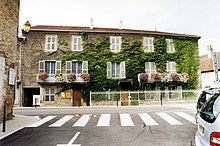
Pasteur's residence in Arbois. Here Pasteur usually spent the summer from mid-July to mid-September.
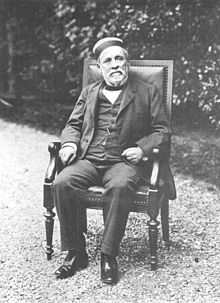
The last photo of Pasteur from 1895

During the 1848 revolution in Paris, Pasteur was briefly a member of the National Guard.
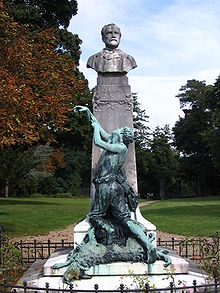
Bust of Louis Pasteur at the entrance to Saint-Cloud Park

Louis Pasteur 1857
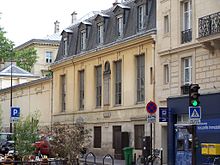
Pasteur's laboratory at the École Normale Supérieure in the rue d'Ulm in Paris
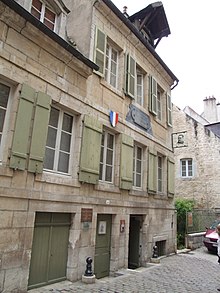
Birthplace of Louis Pasteur in Dole
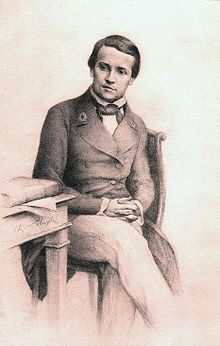
Louis Pasteur 1845 at the École Normale Supérieure (drawing by Charles Lebayle after a daguerreotype)
Honors
In 1883, Pasteur was elected to the American Academy of Arts and Sciences and the National Academy of Sciences. In 1887, the Institut Pasteur was founded. Pasteur lived in the first building of the Institute during the last years of his life (from 1888). The Musée Pasteur has been housed in part of this building since 1936. Other museums exist in his former residences in Dole and Arbois (see Maison de Louis Pasteur).
Numerous monuments have been erected in his honour. At times, French polls considered Pasteur to be the most important Frenchman who ever lived, even ahead of Napoleon.
He is one of 23 original names on the London School of Hygiene and Tropical Medicine frieze listing individuals who have made outstanding contributions to public health and tropical medicine.
While his memory was guardedly cultivated in Germany, Pasteur was especially popular in Russia. Tsar Alexander III was one of the most generous donors to the Institut Pasteur with a contribution of 100,000 francs. Numerous Russian scientists came to Paris, among them the future Nobel Prize winner Ilya Metschnikov, in whose section at the Institut Pasteur a Russian colony was formed for a time.
The bacterial family Pasteurellaceae with the genus Pasteurella is named after Pasteur. The diseases caused by Pasteurella multocida are called "Pasteurelloses". The asteroid (4804) Pasteur also bears his name, as do the lunar crater Pasteur and the Martian crater Pasteur.
His collège in Arbois, a town in Algeria and a district in Canada were named after Pasteur. More than 2000 streets in France bear his name, including Boulevard Pasteur, a major Parisian artery. The Métro runs to the Pasteur station there. The Pasteur Peninsula and Pasteur Island in Antarctica also bear his name in his honour. The passenger ship Pasteur, which entered service in 1939, was also named after him.
The Louis Pasteur Medal, also named after him, is a prestigious scientific honor for physicians. It was awarded by the Louis Pasteur University of Strasbourg before 2009.
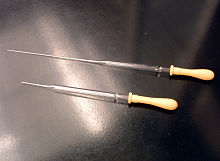
Pasteur pipettes

Pasteur's portrait adorned the last five-franc banknote.
Questions and Answers
Q: Who was Louis Pasteur?
A: Louis Pasteur was a French microbiologist and chemist.
Q: What is Louis Pasteur famous for?
A: Louis Pasteur is famous for supporting the germ theory of disease through his experiments and for creating the first vaccine against rabies.
Q: When was Louis Pasteur born?
A: Louis Pasteur was born on December 27, 1822.
Q: What was Louis Pasteur's wife's name?
A: Louis Pasteur's wife's name was Marie.
Q: What was the germ theory of disease?
A: The germ theory of disease was a theory that proposed that microorganisms are the cause of many diseases.
Q: What was Louis Pasteur's most notable vaccine?
A: Louis Pasteur's most notable vaccine was the first vaccine against rabies.
Q: When did Louis Pasteur die?
A: Louis Pasteur died on September 28, 1895.
Search within the encyclopedia